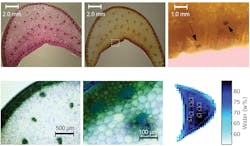Terahertz imaging offers window into new biological insights
The interaction of matter and electromagnetic radiation is determined by the match between the material’s energy states and the incident radiation energy. X-rays, for example, interact with inner shell electrons of high-atomic number elements, so they’re blocked by dense bone calcium and transmitted through soft tissue. Meanwhile, UV light matches the transition energy of outer shell electrons, making it strongly absorbed by nearly everything, including living tissue.
Measuring reflected or transmitted light of different wavelengths provides unique information about the matter being irradiated, which is why there’s a great deal of interest in terahertz waves—the wavelength region between about 30 µm and 3 mm, corresponding to frequencies from 10 to 0.1 THz. Terahertz frequencies are difficult to both generate and detect; only in the last few decades has the technology become practical. A representative example comes via researchers led by Enrique Castro-Camus, a professor at the Centro de Investigaciones en Optica (Leon, Mexico). He and his team have used terahertz imaging to investigate water retention mechanisms in succulent plants—in particular agaves, which are most famous for being used to make tequila.
Like water in agave
Succulents are not a strictly defined plant category, but a good working definition is they are plants that store water in usable form, such that they can retain some level of physiological activity under prolonged drought conditions. It’s not hard to see that succulence is thus a desirable trait for any drought-tolerant plant. However, if agricultural engineers look to incorporate that capability into crop plants, they must have a detailed understanding of the mechanisms of water storage and release.
Terahertz waves, similar to radio waves, are weakly attenuated by many materials yet strongly absorbed by water. In the same way that x-rays provide insight into bone structure in humans, terahertz waves can provide insight into the water distribution in plants. Castro-Camus and his colleagues have done exactly that, investigating the distribution of water in Agave victoriae-reginae, the royal agave.1 They removed three leaves each from two different 4-year-old plants, then sliced each of the leaves at 12 places. The team then placed each of the 600 µm cross-sectional slices into a terahertz time-domain spectrometer, in which both the terahertz generation and detection are triggered by a femtosecond optical pulse. Part of the light strikes a photoconductive switch that emits an electromagnetic pulse with a frequency range of 0.1 to 2 THz. The terahertz beam goes through a 1.5 mm pinhole, through the sample, and then is incident on another photoconductive switch. The other part of the femtosecond pulse also strikes a second photoconductive switch that detects the terahertz pulse. Each leaf slice was translated, producing a map of terahertz absorption across the slice, which the researchers converted into water percentage values (see figure).
More than meets the eye
The aforementioned results show the way water distributes within the leaves of agaves with unprecedented detail. However, these images do not tell the full story. So, the research team went further, performing standard light microscopy and histology to identify the vasculature within the leaves and distinguish the chlorenchyma—plant tissue containing dense chloroplasts—from the hydrenchyma, which is carbohydrate-rich tissue.
The vasculature extends throughout the inner tissue, and its outer reaches define the border between the hydrenchyma and the outer tissue. Even in the basal part of the leaves, where chloroplasts are rare, the outer tissue was relatively water-poor, indicating the presence of chloroplasts was not directly connected to water concentration.
Agave is rich in fructans, polymers of fructose. In fact, agave fructans are fabricated, on average, from 22 fructose monomers. In earlier work, Castro-Camus used terahertz spectroscopy to determine that agave fructans form extraordinarily large hydration shells around them; this means they act as a “molecular sponge,” holding about 300 water molecules.2 Comparing histology to terahertz imaging, the high water content area corresponds to the regions with high fructan content.
According to Castro-Camus, “this terahertz imaging has produced the most detailed study ever presented of the water content distribution in succulent plants.” While the researchers were able to determine the position of vascular channels and other features within the leaves, they recognize that, in principle, terahertz imaging is capable of more detailed and less invasive imaging.
“With higher signal-to-noise, it should be possible to determine the water distribution in living plants in a nondestructive way,” the researchers say, “such that we cannot just have a single 3D image, but a 3D movie of how water distributes in the plant over time and under different water availability conditions.”
Such eventual measurements will help to elucidate the mechanisms of drought protection in succulents and can potentially guide future agricultural practices.
REFERENCES
1. A. K. Singh et al., Sci. Rep., 10, 1404 (2020); doi:10.1038/s41598-020-58277-z.
2. J. A. Morales-Hernández et al., Food Chem., 291, 94–100 (2019); doi:10.1016/j.foodchem.2019.03.132.
About the Author
Richard Gaughan
Contributing Writer, BioOptics World
Richard Gaughan is the Owner of Mountain Optical Systems and a contributing writer for BioOptics World.

